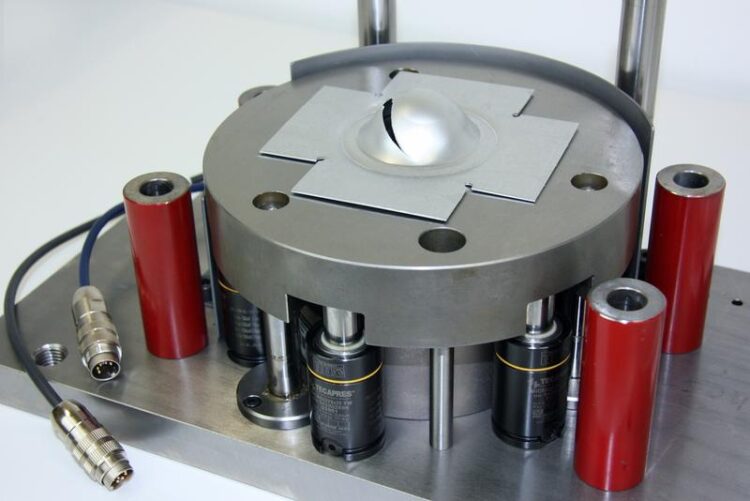Rapid material testing during sheet metal processing reduces failure and scrap

In the testing machine, a hemispherical stamp pushes the component down to a defined depth.
© Fraunhofer
Fraunhofer researchers have developed an innovative process for the initial testing of sheet metal in production systems. The process involves combining tried and proven load tests with an AI software solution. Even before the first machining step, the software creates a prediction about how the material will behave during production and gauges whether it will meet quality requirements. This drastically reduces the risk of failure and amount of scrap.
Sheet metal is now used as a material in practically every industrial sector. In the automotive or electrical industry, in mechanical engineering and plant construction, in furniture manufacturing and in the packaging industry – sheet metal is utilized everywhere. There is a tremendous diversity of alloy compositions, thicknesses, coatings and colors available for these applications. According to the Association for the Sheet Metal Forming Industry, the sector achieved revenues of some 20.5 billion euros in 2019 alone.
Sheet metal is usually delivered in the form of large coils or panels. The material undergoes various machining steps before the final product emerges. It is trimmed, bent, compressed, pulled or embossed. Trouble-free further processing in production therefore hinges on a quality control system to guarantee that the material satisfies all required specifications.
In this context, Fraunhofer Institute for Machine Tools and Forming Technology IWU has lent a helping hand by presenting its “material tester”. It tests the sheet metal quickly and easily before the first machining step. The researchers have refined tried and proven mechanical load tests and combined them with machine learning software. This software creates a sophisticated prediction about how a material will behave at every machining step throughout the production sequence.
How the material test works
First, a small section of the sheet metal is cut off and placed in a testing machine. A stamp in the shape of a dome, or a different shape depending on the application, pushes the metal down to a predefined depth. A force sensor measures the force-displacement profile. In other words, it records the amount of force required to deform the material up to a specific point.
“The analysis software uses these measurements to draw conclusions about the deformation behavior under pressure and assesses the suitability of the metal for the planned production process,” explains Matthias Riemer, Project Manager at Fraunhofer IWU.
Machine learning algorithms control the traffic light symbol of the prediction system
To make sure the software is able to create a viable prediction, numerous individual specimens of new sheet metal types are first deformed in the testing machine. The force-displacement profile measurements generated by this process are used as data to train the machine learning algorithms. The result is a behavior profile of the sheet metal type as a reference. When a sheet metal coil from a different batch of the same material is tested, the ML algorithms compare these measurements with the existing profile and visualize the result in a graph.
The production staff is provided with a sophisticated statement about resilience and the material’s behavior. They do not have to concern themselves with the technical details. A traffic light symbol in the material tester software indicates whether the sheet metal is “OK”, “marginally useful” or even “scrap”. If the analysis shows that the delivered sheet metal does not meet the agreed specifications, the company can run additional tests on the product and then decide whether to return it to the supplier or modify the production process.
Experts at Fraunhofer IWU programmed the software for this project themselves. It works with standard control computers in use at testing stations in factories. The entire test takes just 15 seconds.
Material tests after a prolonged period of storage
The material tester by Fraunhofer IWU comprises a departure from previous testing concepts that would inspect the sheet visually for cracks or defects after the load test. “Instead of examining the material, we use ML algorithms to analyze the measurements. This kind of prediction is more reliable and sophisticated than a conventional load test,” says Riemer. The tests can also be useful if the delivered coils have been stored under fluctuating temperatures for a prolonged period or in a hall without air conditioning during the summer months. Such situations can cause some materials such as certain aluminum alloys to show signs of aging.
Matthias Riemer believes it is especially important to perform the material test before the first machining step: “Some manufacturers forgo initial tests and rely completely on the specifications agreed upon with the supplier. That can be a risky business.”
Presentation at the Hannover Messe
The material tester can either be set up in the warehouse as a stand-alone solution at the initial testing station or as an inline solution at the start of the production line. The system is compatible with existing testing machines. There is no need to acquire new testing facilities.
The IWU team will be presenting the material tester at the Hannover Messe. The event will be held virtually from April 12 to April 16.
Weitere Informationen:
https://www.fraunhofer.de/en/press/research-news/2021/march-2021/rapid-material-…
Media Contact
All latest news from the category: Trade Fair News
Newest articles

NASA: Mystery of life’s handedness deepens
The mystery of why life uses molecules with specific orientations has deepened with a NASA-funded discovery that RNA — a key molecule thought to have potentially held the instructions for…

What are the effects of historic lithium mining on water quality?
Study reveals low levels of common contaminants but high levels of other elements in waters associated with an abandoned lithium mine. Lithium ore and mining waste from a historic lithium…

Quantum-inspired design boosts efficiency of heat-to-electricity conversion
Rice engineers take unconventional route to improving thermophotovoltaic systems. Researchers at Rice University have found a new way to improve a key element of thermophotovoltaic (TPV) systems, which convert heat…



